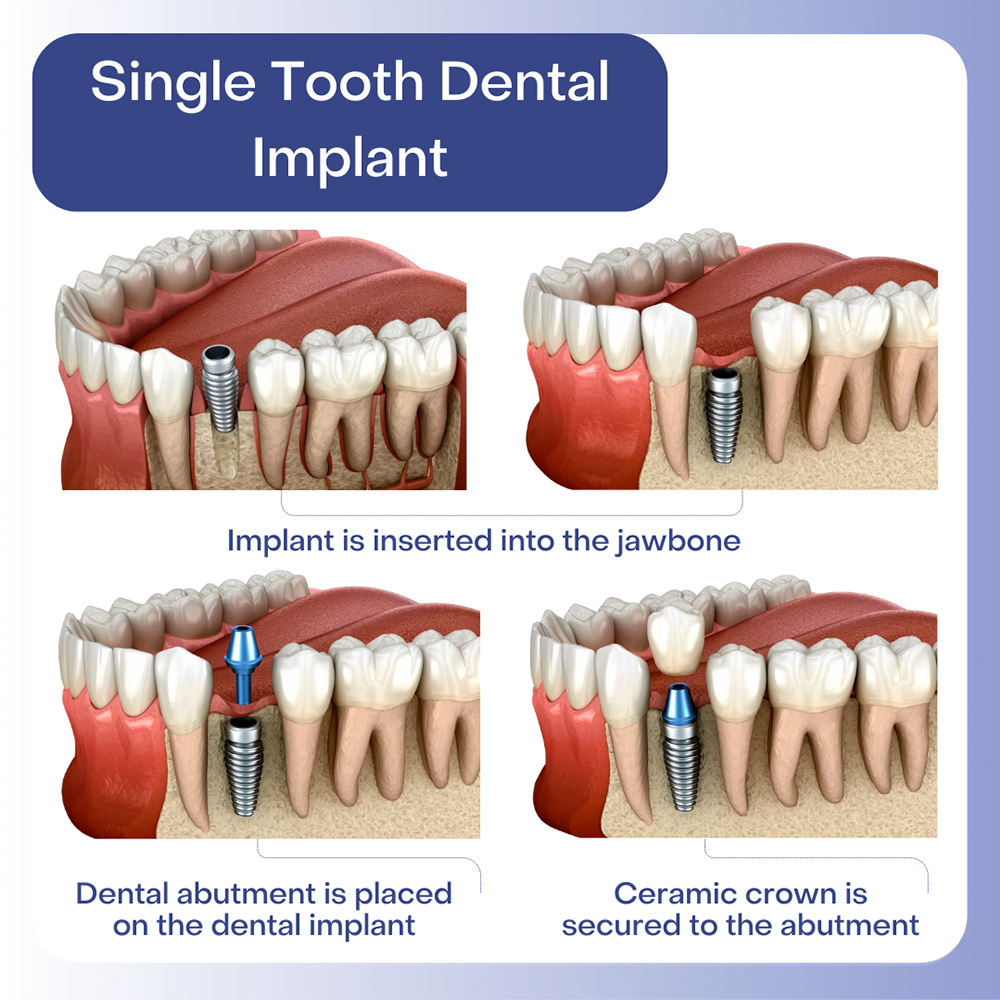Facts About Dental Sense Revealed
Facts About Dental Sense Revealed
Blog Article
Fascination About Dental Sense
Table of ContentsThe 5-Second Trick For Dental SenseA Biased View of Dental SenseThe 10-Second Trick For Dental SenseDental Sense for Beginners
are clinical tools surgically implanted right into the jaw to restore an individual's capability to eat or their appearance. They supply assistance for synthetic (fake) teeth, such as crowns, bridges, or dentures. When a tooth is shed due to injury or illness, an individual can experience difficulties such as quick bone loss, defective speech, or adjustments to chewing patterns that lead to discomfort.Oral dental implant systems consist of an oral implant body and dental implant abutment and may additionally consist of an abutment fixation screw. Front tooth filling. The oral implant body is operatively placed in the jawbone instead of the tooth's origin. The oral implant joint is typically connected to the implant body by the abutment fixation screw and expands with periodontals right into the mouth to sustain the connected artificial teeth
(https://www.storeboard.com/dentalsense)Structure of The Dental Implant System choosing dental implants, talk to your oral company about the prospective benefits and threats, and whether you are a candidate for the procedure. Points to take into consideration: Your total health and wellness is a vital factor in figuring out whether you are a good candidate for dental implants, how much time it will certainly require to recover, and how long the implant may remain in place.
Smoking cigarettes might affect the recovery process and decrease the long-term success of the dental implant. The healing process for the dental implant body might take numerous months or longer, during which time you normally have a temporary joint in location of the tooth. the dental implant procedure: Very carefully follow the oral hygiene directions offered to you by your dental provider.
The 5-Minute Rule for Dental Sense
Implant failure can lead to the need for another surgery to fix or change the implant system. Recovers the ability to chew Recovers aesthetic look Helps maintain the jawbone from diminishing due to bone loss Protects the health and wellness of the bordering bone and gums Assists maintain surrounding (neighboring) teeth secure Improves lifestyle Damage to surrounding all-natural teeth during dental implant placement Injury to the surrounding tissues during surgical treatment, such as sinus opening Injury throughout surgical treatment (for example, fracture of surrounding jawbone) Insufficient feature, such as feeling like the teeth do not bite with each other generally A feeling that the tooth is loosened or turning in place arising from a joint screw loosening up Implant body failure (looseness of the dental implant body) due to systemic infection, which might be more probable in individuals with unchecked diabetics issues as a result of regional infection in bone and gums supporting the dental implant body as a result of postponed healing, which might be more probable in people who smoke Problem cleansing the periodontals around the dental implant, resulting in poor dental health Untreated gum illness Post-surgical feeling numb because of nerve impingement or damage Always notify health care providers and imaging technicians that you have dental implants prior to any magnetic vibration imaging (MRI) or x-ray procedures.
FDA is not knowledgeable about any kind of negative occasions reported for MRI or x-ray procedures with oral implants. Oral implants systems are generally constructed from materials that adhere to worldwide consensus criteria of the International Company for Standardization (ISO) or ASTM International. These requirements have details of what makes a secure material.

A dental implant is a framework that changes a missing out on tooth. With screw-like devices, the cosmetic surgeon inserts an implant into the jawbone, and it serves as an anchor for an artificial tooth, called a crown. A tool called an abutment connects the fabricated tooth to the dental implant. The crown is personalized to fit the individual's mouth and match the shade of their teeth.
The Best Strategy To Use For Dental Sense
Some individuals are not eligible for oral implant surgical treatment. It is for oral specialists to operate individuals with: severe illnessuncontrollable metabolic diseasebone or soft cells illness or infectionIf these problems are fixed, a person can have the surgery. In, dental surgeons avoid operating on people with: If people with any one of the above go through oral implant surgical treatment, there is a greater threat of the implant falling short.

Oral dental implant surgery is a tailored procedure. Provide you time to heal. Attach the article and last crown, bridge or denture.
Next, your specialist will meticulously place the oral implant into your jaw. If your dental implant is near the front of your mouth, your dental professional will certainly make a short-lived tooth for you to use up until you recover.
Things about Dental Sense
Your copyright can inform you what to anticipate in your circumstance. Throughout the recovery stage, your jawbone should fuse to the oral implant. This procedure, called osseointegration, is crucial for stability and lasting success. This process can take anywhere from 3 to nine months. In many cases, it may take much longer.
When your implant heals, your dentist can connect the abutment (small adapter blog helpful resources post) and your last remediation (crown, bridge or denture). This usually takes about one hour to complete and may call for a 2nd minor surgical treatment. You shouldn't really feel any type of discomfort during your dental implant procedure because your copyright will use medicine to numb your gums.
Report this page